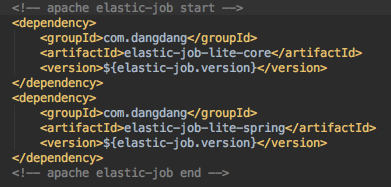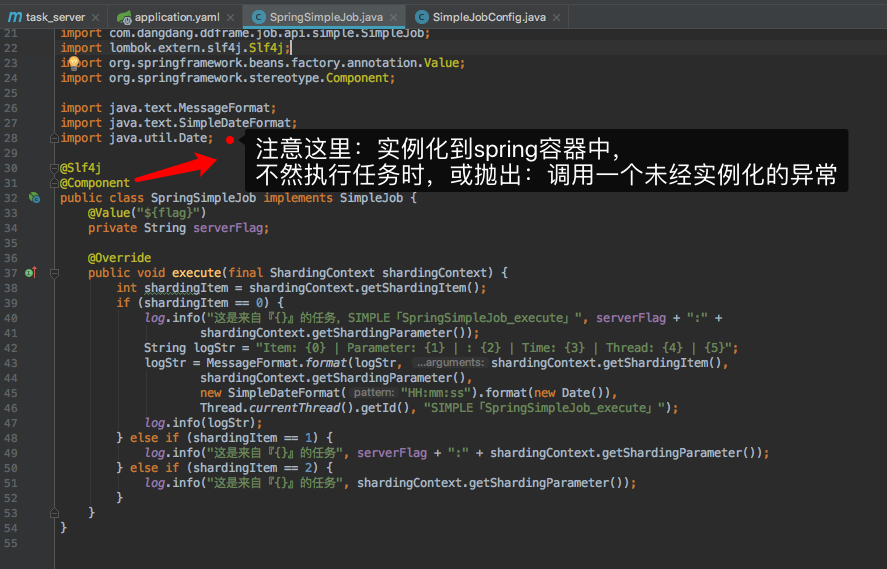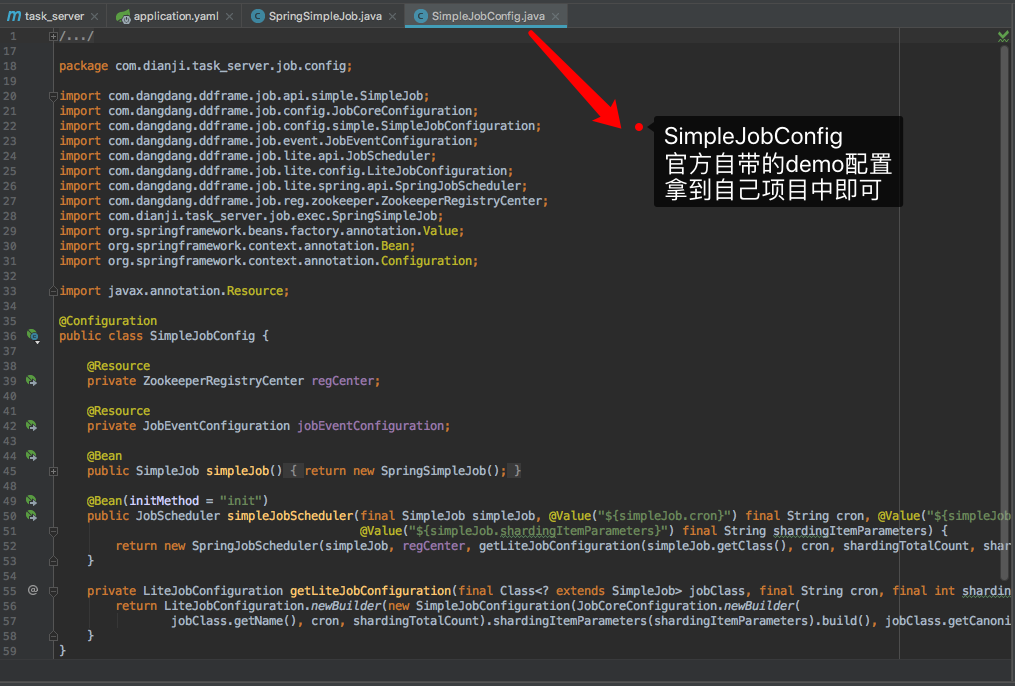第一篇需要实现一个最简单的需求:某个任务定时执行,多台机子只让其中一台机子执行任务
一、安装 分布式应用程序协调服务 zookeeper,安装步骤在链接里面
Linux(Centos7)下安装 zookeeper docker版 集群
二、在springboot项目中引入 elastic-job 依赖,我这里用的 springboot 2.0.5 版本
整合代码参考官方的springboot demo
https://github.com/elasticjob/elastic-job-example
对应的 elastic-job 版本
<elastic-job.version>2.1.5</elastic-job.version>


<!-- apache elastic-job start --> <dependency> <groupId>com.dangdang</groupId> <artifactId>elastic-job-lite-core</artifactId> <version>${elastic-job.version}</version> </dependency> <dependency> <groupId>com.dangdang</groupId> <artifactId>elastic-job-lite-spring</artifactId> <version>${elastic-job.version}</version> </dependency> <!-- apache elastic-job end -->
application.yaml 加入配置


regCenter:
serverList: localhost:2181
namespace: my-project
simpleJob:
cron: 0/15 * * * * ?
shardingTotalCount: 1
shardingItemParameters: 0=a
dataflowJob:
cron: 0/5 * * * * ?
shardingTotalCount: 3
shardingItemParameters: 0=Beijing,1=Shanghai,2=Guangzhou
三、作业代码(simpleJob类型的任务),把官方的demo拿到自己的项目中来就行,注意添加一个@Component注解在类上


/* * Copyright 1999-2015 dangdang.com. * <p> * Licensed under the Apache License, Version 2.0 (the "License"); * you may not use this file except in compliance with the License. * You may obtain a copy of the License at * * http://www.apache.org/licenses/LICENSE-2.0 * * Unless required by applicable law or agreed to in writing, software * distributed under the License is distributed on an "AS IS" BASIS, * WITHOUT WARRANTIES OR CONDITIONS OF ANY KIND, either express or implied. * See the License for the specific language governing permissions and * limitations under the License. * </p> */ package com.dianji.task_server.job.exec; import com.dangdang.ddframe.job.api.ShardingContext; import com.dangdang.ddframe.job.api.simple.SimpleJob; import lombok.extern.slf4j.Slf4j; import org.springframework.beans.factory.annotation.Value; import org.springframework.stereotype.Component; import java.text.MessageFormat; import java.text.SimpleDateFormat; import java.util.Date; @Slf4j @Component public class SpringSimpleJob implements SimpleJob { @Value("${flag}") private String serverFlag; @Override public void execute(final ShardingContext shardingContext) { int shardingItem = shardingContext.getShardingItem(); if (shardingItem == 0) { log.info("这是来自『{}』的任务,SIMPLE「SpringSimpleJob_execute」", serverFlag + ":" + shardingContext.getShardingParameter()); String logStr = "Item: {0} | Parameter: {1} | : {2} | Time: {3} | Thread: {4} | {5}"; logStr = MessageFormat.format(logStr, shardingContext.getShardingItem(), shardingContext.getShardingParameter(), new SimpleDateFormat("HH:mm:ss").format(new Date()), Thread.currentThread().getId(), "SIMPLE「SpringSimpleJob_execute」"); log.info(logStr); } else if (shardingItem == 1) { log.info("这是来自『{}』的任务", serverFlag + ":" + shardingContext.getShardingParameter()); } else if (shardingItem == 2) { log.info("这是来自『{}』的任务", shardingContext.getShardingParameter()); } } }
四、配置作业(直接将官方的配置代码拿进自己的项目中)


/* * Copyright 1999-2015 dangdang.com. * <p> * Licensed under the Apache License, Version 2.0 (the "License"); * you may not use this file except in compliance with the License. * You may obtain a copy of the License at * * http://www.apache.org/licenses/LICENSE-2.0 * * Unless required by applicable law or agreed to in writing, software * distributed under the License is distributed on an "AS IS" BASIS, * WITHOUT WARRANTIES OR CONDITIONS OF ANY KIND, either express or implied. * See the License for the specific language governing permissions and * limitations under the License. * </p> */ package com.dianji.task_server.job.config; import com.dangdang.ddframe.job.api.simple.SimpleJob; import com.dangdang.ddframe.job.config.JobCoreConfiguration; import com.dangdang.ddframe.job.config.simple.SimpleJobConfiguration; import com.dangdang.ddframe.job.event.JobEventConfiguration; import com.dangdang.ddframe.job.lite.api.JobScheduler; import com.dangdang.ddframe.job.lite.config.LiteJobConfiguration; import com.dangdang.ddframe.job.lite.spring.api.SpringJobScheduler; import com.dangdang.ddframe.job.reg.zookeeper.ZookeeperRegistryCenter; import com.dianji.task_server.job.exec.SpringSimpleJob; import org.springframework.beans.factory.annotation.Value; import org.springframework.context.annotation.Bean; import org.springframework.context.annotation.Configuration; import javax.annotation.Resource; @Configuration public class SimpleJobConfig { @Resource private ZookeeperRegistryCenter regCenter; @Resource private JobEventConfiguration jobEventConfiguration; @Bean public SimpleJob simpleJob() { return new SpringSimpleJob(); } @Bean(initMethod = "init") public JobScheduler simpleJobScheduler(final SimpleJob simpleJob, @Value("${simpleJob.cron}") final String cron, @Value("${simpleJob.shardingTotalCount}") final int shardingTotalCount, @Value("${simpleJob.shardingItemParameters}") final String shardingItemParameters) { return new SpringJobScheduler(simpleJob, regCenter, getLiteJobConfiguration(simpleJob.getClass(), cron, shardingTotalCount, shardingItemParameters), jobEventConfiguration); } private LiteJobConfiguration getLiteJobConfiguration(final Class<? extends SimpleJob> jobClass, final String cron, final int shardingTotalCount, final String shardingItemParameters) { return LiteJobConfiguration.newBuilder(new SimpleJobConfiguration(JobCoreConfiguration.newBuilder( jobClass.getName(), cron, shardingTotalCount).shardingItemParameters(shardingItemParameters).build(), jobClass.getCanonicalName())).overwrite(true).build(); } }
五、最简单的整合步骤就完成了,启动应用(分别启动三个进程),看见任务开始执行了
最简单的任务需求得到了满足,定时执行,多台机子只让其中一台机子执行任务

关于分片的数量设置,实际操作了一把
假如:有3个进程实例
并且elastic-job 设置
分片 1 时:3个进程只有1一个进程执行1次任务,共执行1次任务
分片 2 时:3个进程中的2个进程一共执行2次任务,共执行2次任务
分片 3 时:3个进程每个执行1次任务,共执行3次任务
分片 4 时:3个进程同时一共执行4次任务,共执行4次任务
分片 5 时:3个进程同时一共执行5次任务,共执行5次任务
分片为X时,此任务同时在Y台个进程里面执行X次。
这样就可以根据不同的使用场景配置不同的分片数量了
